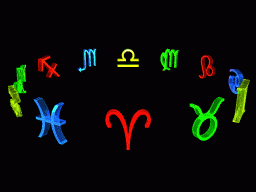












Astrology Made Easy












Welcome to Astrology Made Easy. This page will guide you through the basics of astrology as it is practiced today. You will be an apprentice astrologer in no time. Now get to it!

Crazy Calculations
First we have to talk about how astrology is calculated.Western astrology is no longer accurate to our current astronomical alignments. As the earth rotates, it undergoes axial precession, meaning that over time, gravitational force changes the orientation of that rotational axis. Fixed stars have "moved backwards" from the earlier human perspective.
Hipparchus of Nikaia is generally accepted as the first to discover this phenomenon in approximately 134 BC. By following the Greek method in modern practice, calculations are tropical; the gradual precession period of our rotation marked by 100 BC is not accounted for.
Ophiuchus, the serpent bearer, is also unaccounted for. The Babylonians didn't include this large constellation, but the sun now spends more time in it than the nearby Scorpius. The sun spends less than a week in Scorpius and just over two weeks in Ophiuchus. This anomaly is due to the redrawing of the constellation boundaries by the International Astronomical Union in 1928.
But, as long as you're OK with doing things the old way, the inaccuracies are not a problem.
If you are interested in an "up to date" system, sidereal charts such as those calculated in Vedic astrology do account for precession by the use of corrective ayanamśa. The difference may seem dramatic to some.
Your Aries friend would now be a Pisces through this calculation. A Virgo becomes a Leo. The sidereal formula must be done separately and specifically, but websites for it are also freely available online.

Mapping a birth chart from the Astrologosphere

You may want to read about your natal (birth) chart for more information about your own astrology. You can easily obtain this on a website that offers free chart readings. It'll be presented to you in either a circular drawing or a list including the degrees and constellations which the luminaries (Sun and Moon) and planets were in while you were born.
You also have the option of calculating the placements of certain asteroids, comets, and other fun stuff. Most people into astrology these days identify with their Sun, Moon, and Rising (Ascendant) and this combination has been given the colloquial name of "your big three."
From what I've seen in old forums- late 90s to early 2000s- people used to casually identify with their Sun and Rising rather than the big three like we do online today. I've seen a lot of, "I'm a Scorpio (Sagittarius Rising...whatever that means to you)" and "Gemini, Leo Rising, for all the other astrology freaks out there."
How to read a chart
Now we will talk about how to actually work with the real deal: charts.Taurus always follows Aries, Gemini always follows Taurus, and so on. It is as if we were spinning a ship wheel with numbered spokes. If we know where spoke number seven is, we can locate eight and nine with no trouble. When the sun set on some particular October evening, Libra was setting too. At that time of year, the sun and Libra are a package deal.
With Libra setting in the west, Aries— its opposite sign— must be rising in the east. And Pisces, the sign immediately before Aries, just finished rising. Taurus, the following sign, is just below the eastern horizon, getting ready to come up. It works just like the wheel of a ship.
Here's an example of a circular chart wheel with Gemini Sun, Sagittarius Moon, and Scorpio Rising. The Rising is the starting point. Look to the left where you see the blue symbol for Scorpio and "AC" written on the degree where the Ascendant is. All western chart wheels will appear rotated like this.

Notice the numbers in the middle of the circle? Those are there to easily help you with what sections of this wheel make up which houses. Not all calculators include those numbers, but the Rising is naturally always the 1st house, so you'll be able to count them yourself. As you can see, this chart's Sagittarius Moon is in the 2nd house.
Amazing Ascendant
In this section, we will talk about the Ascendant, AKA the Rising sign.Because it's not a planet, or even any physical object at all, you may be inclined to overlook your Rising sign. Well what is it then? It is the degree of the ecliptic which is rising over the Eastern horizon at the precise time and place of an individual's birth. It's the constellation which was rising in the east at the moment of birth, and it is the starting point in astrological interpretations.
The natural inversion of the birth map puts east on the left and west on the right. So planets rise on the left side of the chart. We call that point the Rising or Ascendant. The opposite point, the right end of the horizon line, is where they set. It is called the Descendant.
You may find it very revealing to see how this polarity point applies to you personally. However, you need your exact time of birth to get it. Once established, it is possible to "map out" the planets into houses by using the Rising as a starting point.
In Hellenistic times, the Ascendant was the helm (οἴαξ, oiax) of the ship by which we steer the course of our life. My opinion is that the sign on the Ascendant correlates with the desires that the person has on a subjective level: those which support their own sense of self-discovery as an independent being distinct from everyone else. So this placement operates instinctively, without forethought or preconception, whereas the persona is a constructed phenomena which more naturally corresponds with the descendant. The Descendant side of the polarity represents how we consciously construct a way of interacting with others.
If you are born at sunrise (or around 06:00 local time), your Rising generally will be the same as your Sun sign. However, this is only a general rule because latitude and longitude as well as whether or not your local area uses any time changes, also play a part in the calculation.
Planet Mercury
In both Mesopotamian and Hellenistic tradition, this planet was seen as both male and female (Akkadian zikar sinniš 'male [and] female') or common of either gender (cf. Ptolemy, Tetrabiblos 1.6 and 7). It was called "star [i.e. planet] of East and West [i.e. sunrise and sunset]."
Mercury represents our need to communicate. It is a key to our verbal ability, our logic, and our capacity to be objective and detached. Mercury symbolizes the conscious, reasoning mind that observes the world, gathers information, learns, teaches, and disseminates knowledge. Wherever Mercury is in our horoscope (by house and sign), we are curious, interested, and want to know. We may learn, and/or teach in that area. Our Mercury placements help to describe our verbal styles and the way we use our minds.
An analysis of Mercury's solar phase as morning star or evening star, direct or retrograde, visible or hidden under the beams of the Sun, can reveal the deeper workings of this planet in individual behavior. Three times each year, Mercury turns retrograde for three weeks. The planet "travels through the underworld" and engages with what is normally hidden from consciousness.
Which of Mercury's faces do you have in your chart– the youthful and energetic gatherer of information and experiences, the wise and thoughtful sage, or the magician who studies and guards the mysteries?
Transpersonal Planets
This section is about the planets Jupiter and Saturn and their roles.These are called the transpersonal planets because their orbits take so long (12 and 29 earth years respectively) that entire generations of people are born under them before they move to the next sign.
Jupiter is the key, guide, and light that sees us through the darkness of time- Saturn. It is the straight and narrow path by which we pass through Saturn's test. Traditionally, Jupiter is the "great benefic" as it shows us how to find our way through life and the tests of Saturn. Jupiter is our key to succession through time, and the key to Saturn's demands; therefore, Jupiter has to do with how we are to be successful in life in our battle against the forces of time (Saturn).
Jupiter is the planet of expansion, abundance and wisdom. It highlights the areas in which we yearn to discover greater truths. Therefore it can also be linked to excess. We search for more and more insofar as we can learn greater truths. It is the seeker. In seeking we find. Jupiter often describes our vocation or the way we may go through life to find the greatest opportunities.
Serapion of Alexandria said, "Whatever gifts Saturn gives, no other star can take away." One of the essential functions of Saturn is to provide a conditioning- bearing both gifts and challenges. An individual with, for example, Saturn in Leo, has a chart that is structurally defined around a Leonean conditioning or archetype. And that then means that every other astrological function, Venus, Mercury, Mars, Pluto, etc. is defined and conditioned by, in this case, the Leonean archetype, meaning the self-creative principle, the inner given right for creative self-actualization.
I DO NOT BELIEVE IN USING URANUS NEPTUNE AND PLUTO AS ASTROLOGICAL INFLUENCES. ITS NOT A BAD THING I JUST DONT CARE FOR THEM. SO YOU WILL HAVE TO GOOGLE THOSE IF YOU WANT TO LEARN ABOUT THEM.
Well now you may be asking why I don't believe in using them for astrology. The answer is that their orbits are just too damn long for it to have any real impact worth talking about. Pluto takes 248 years to move from sign to sign. Frankly I think it's ridiculous to talk about how your Pluto sign impacts you when it impacts everyone else born in the span of 248 years the same way.
Plus these planets were only discovered beginning in the 18th century. The ancients did not know these planets existed and therefore did not use them astrologically. But that is just my opinion.
Spectacular Stelliums
Now let's talk about something a little less well known: stelliums.Having three or more placements in the same sign and house means that you have what is called a stellium. For example, if you have at least three Aries placements in for instance, the 9th house, you have an Aries stellium. This is natural and you can read about its interpretations.
On the other hand, only having one placement in one sign may be called solitary— for example, my only Leo placement is Leo Venus. It's therefore my solitary Leo Venus. These phenomena can work wonders in a chart.
Back to Astrologon homepage
